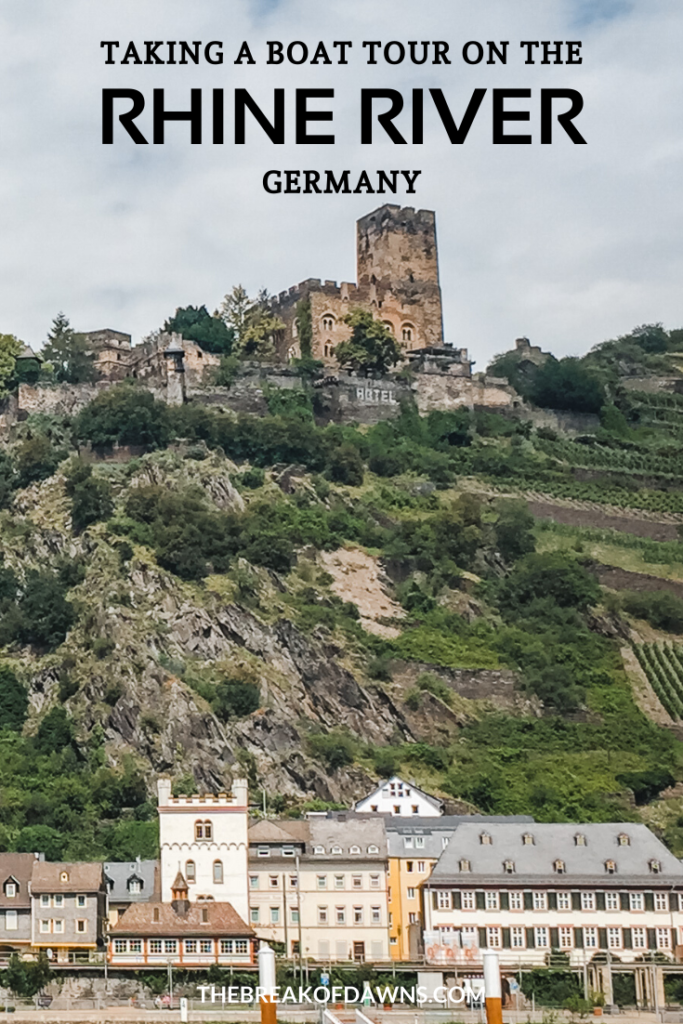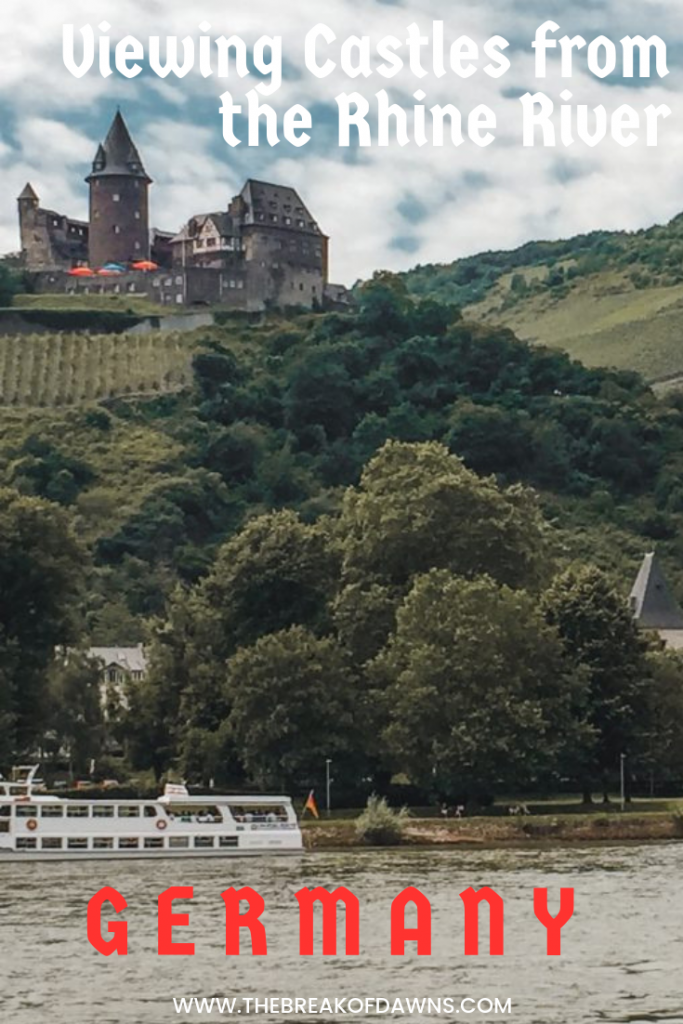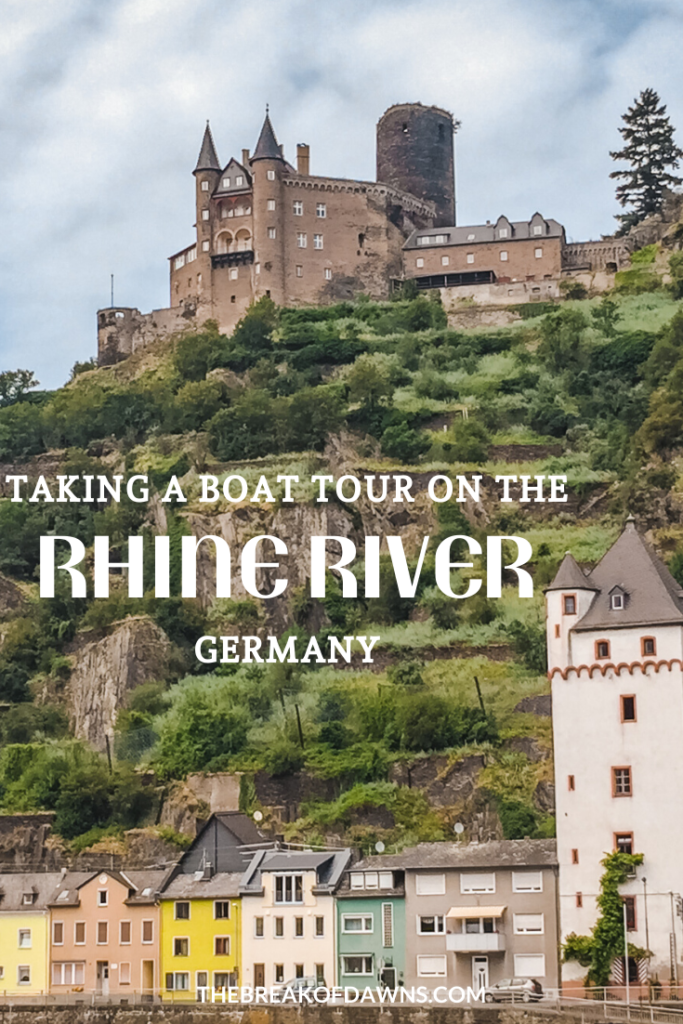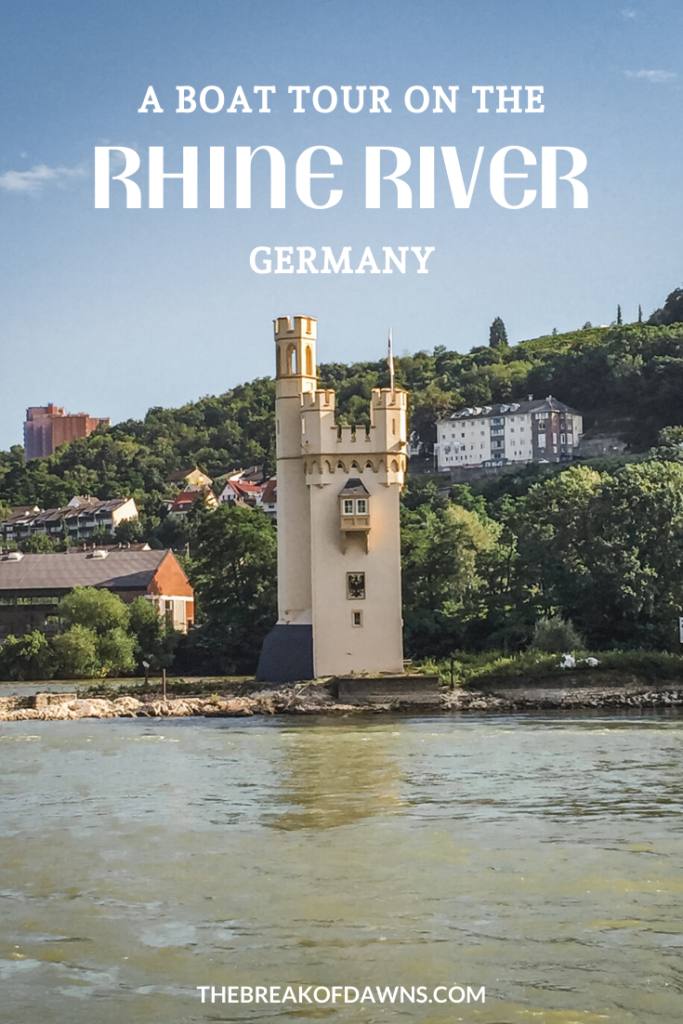
One of the most memorable day trips we took while living in Germany was for our anniversary, a cruise on the Rhine River. With multitudes of castles strung throughout the hilly banks of the river, it’s the best way to see and learn about the reigning history of Germany.
Here’s a Day Cruise on the Rhine River in Germany:
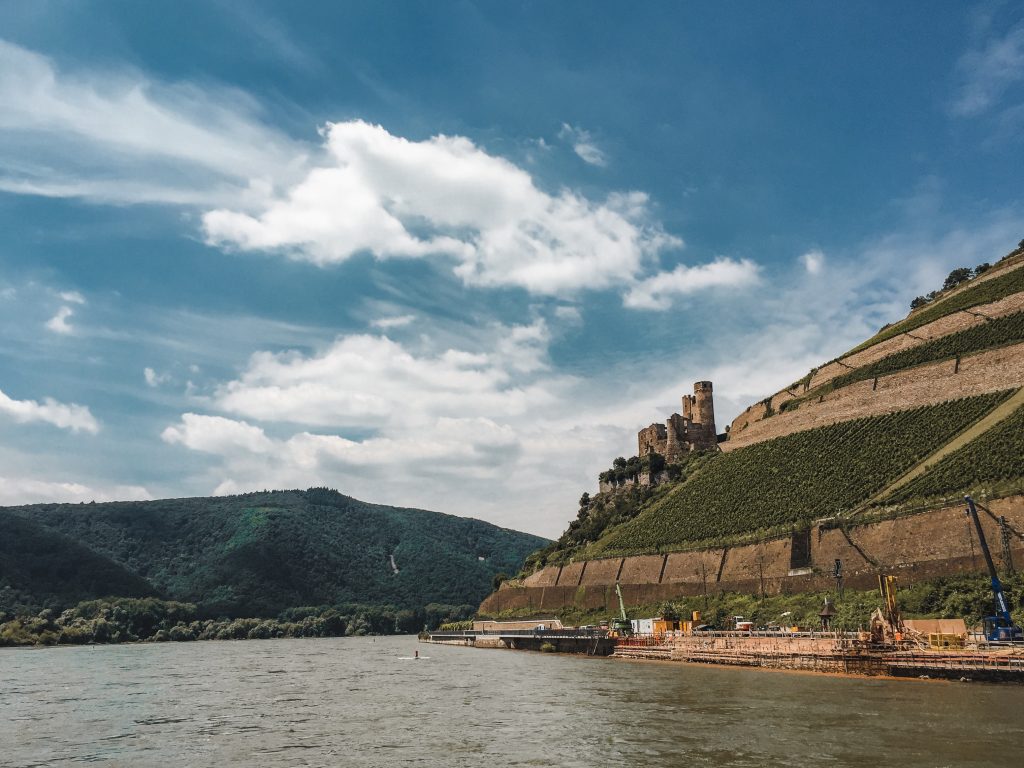
Info for the Rhine River Boat Tour
With multiple route options to choose from, we opt for embarking from Bingen. Buying our tickets through the Bingen-Ruedesheimer company, the cost was around 15 Euro per person.
While there are a multitude of tour options, we chose the castle excursion for a chance to see up to 20 castles. A tour guide on the boat discusses the history behind each as we float by. For an up close and personal castle experience, the boat docks at multiple villages. A second boat rounds back every hour for you to grab and continue on down the river.
Since I wanted to see all of the castles in our short time on the Rhine, we didn’t depart the boat at any time but I loved seeing them from the water.
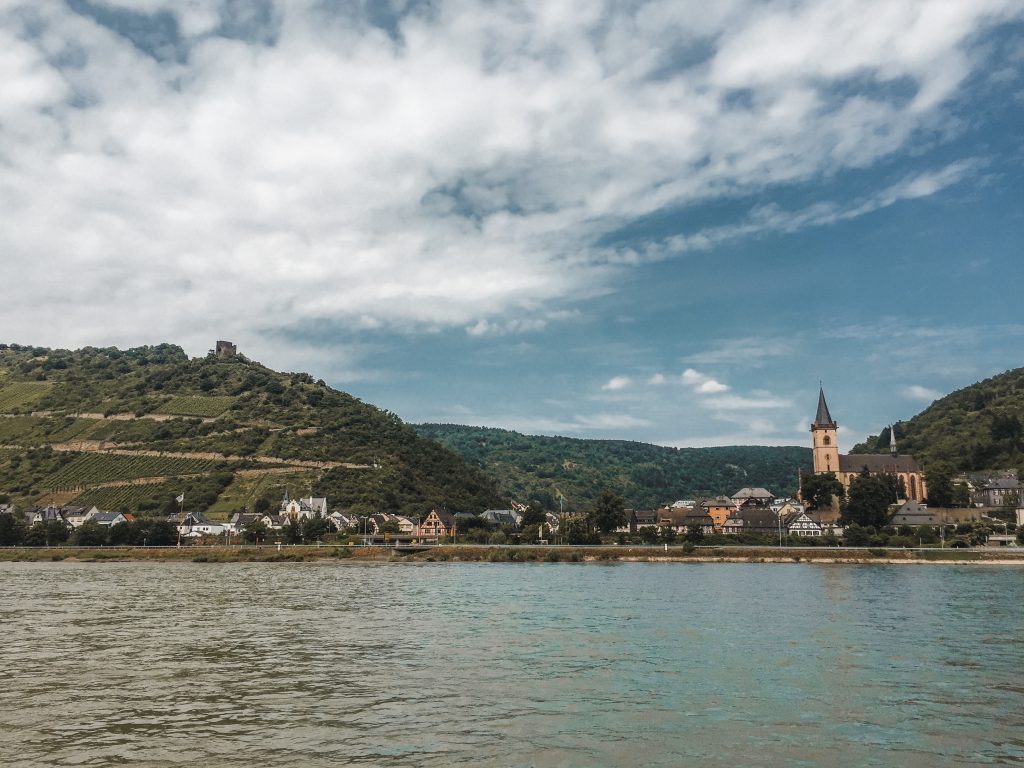
The German Castles Along the Rhine River
With more than 20 different castles to view, it’s hard to decide which one is worthy of your time to stop at. I’ll go into detail about each one in this post, while also giving historic information about them!
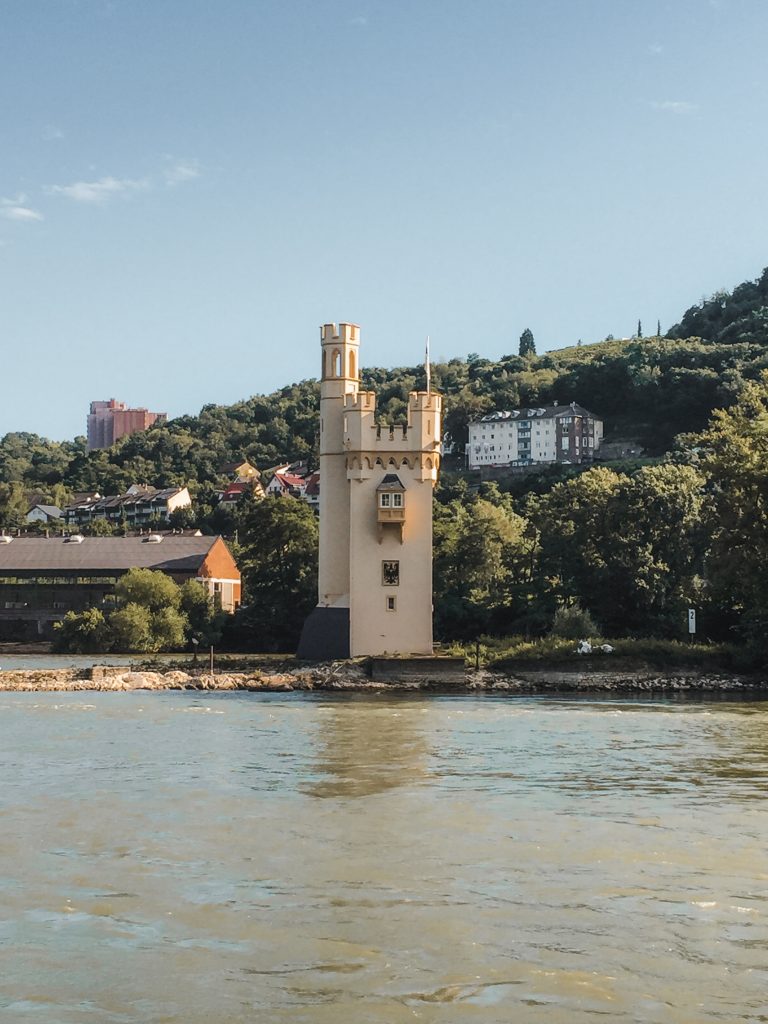
Burg Ehrenfels
Although the actual date of construction is unknown, Burg Ehrenfels was used as a customs point on the Rhine in the 1200s. A ‘Mouse Tower’ was built on an islet in the water across from the castle to ensure complete supervision over the Rhine. Burg Ehrenfels was damaged in the Thirty Years’ War, then completely ruined during the Siege of Mainz in 1689.
Vineyards dating back to the 13th century still dominate the cliff around Burg Ehrenfels, where the Ehrenfelser grape was born.
A hike to the ruins is possible, taking about an hour, but the castle is officially now closed off to tours.
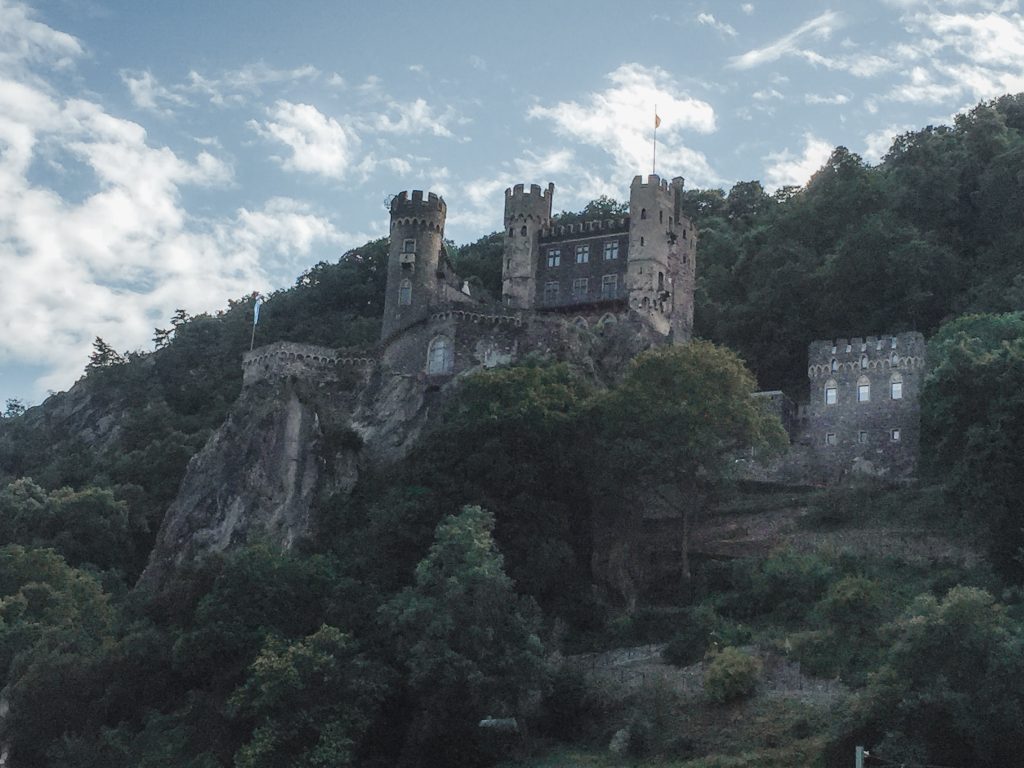
Burg Rheinstein
Only a few years after it was constructed in 1316, Burg Rheinstein suffered from the wars fought around it. In the late 1800s, it was purchased by a Prussian Prince and rebuilt into what stands today. The castle features multiple drawbridges and doors that resemble the Medieval era. With a courtyard hosting a 500 500 year old vineyard, grapes are still produced today.
You can visit Burg Rheinstein on a tour from March to November.
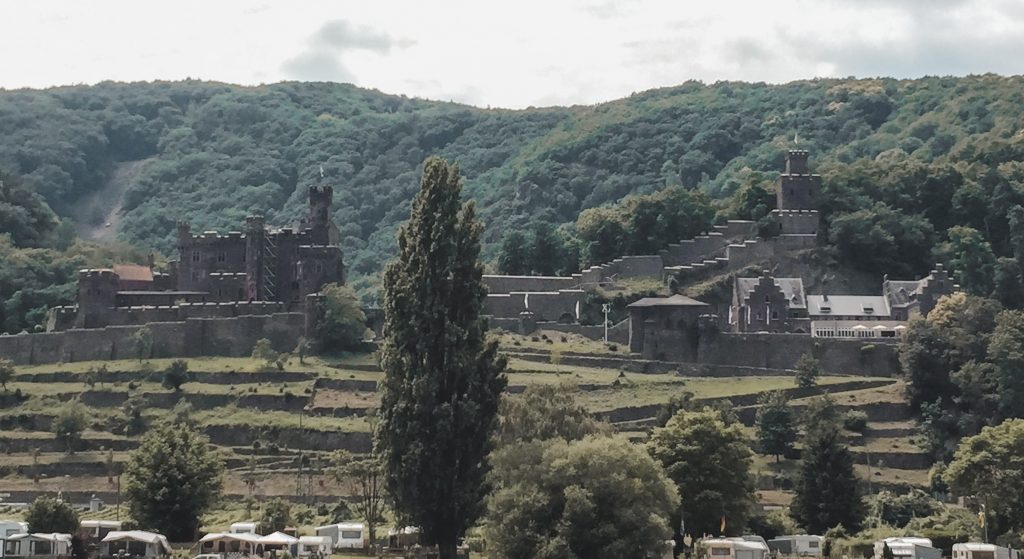
Burg Reichenstein
Burg Reichenstein, also known as Falkenburg, is recognized as a UNESCO World Heritage Sight. While the exact date of construction is unknown, it was first mentioned in 1213. Much debate lies around the history of this castle but theory suggests that Dietrich von Hohenfels’ inherited it after the death of his father. Eventually, Hohenfels became known as a robber knight and had a small army join him. In 1282, King Rudolph I of Habsburg flooded the area of the castle with his men, successfully capturing Hohenfels and his people. He destroyed the hostages and the castle, forbidding it to be rebuilt. Over the next few hundred years, the castle fell into many different hands but was finally restored in 1834 into what it is today.
Burg Reichenstein is open to the public and also features a restaurant and hotel.
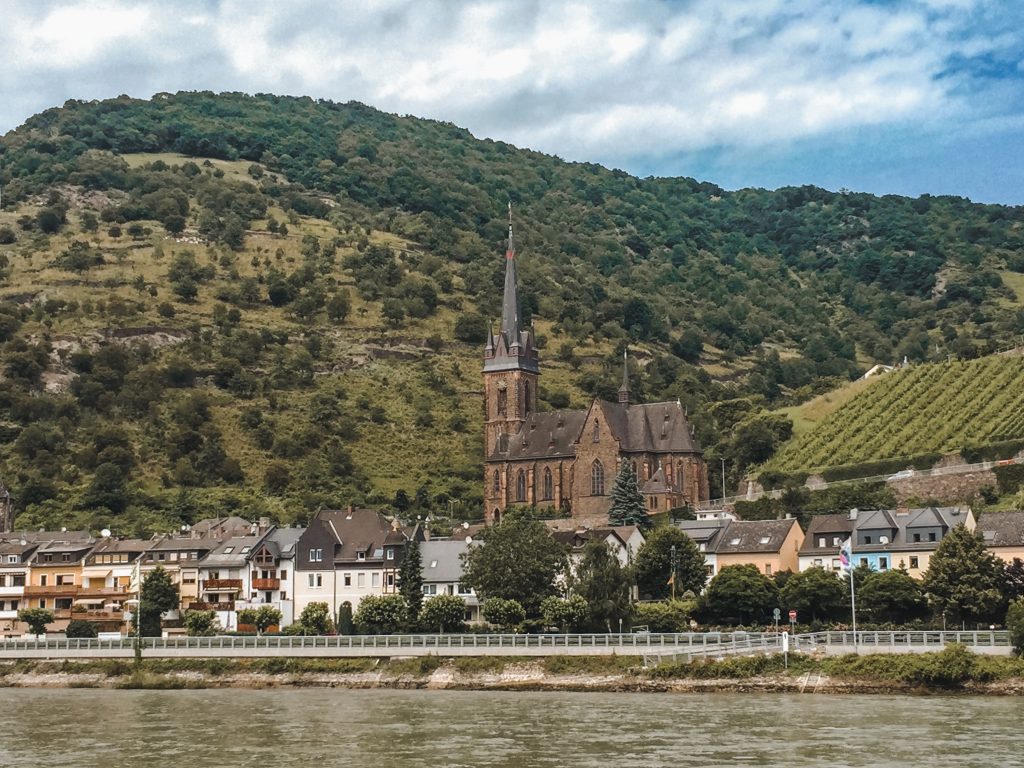
Sooneck
Sooneck, another UNESCO World Heritage Sight, has a similar history to that of Burg Reichenstein. Hohenfels and his Lords ran this castle as well until it was also besieged by King Rudolph I in 1282. The castle fell into many different families over the next 300 years but when their bloodline ran out, it was no longer taken care of. Along with every castle on the left bank of the Rhine, it was destroyed during the War of Palatine Succession, specifically by the army of King Louis XIV of France in 1689. In 1834, the castle was rebuilt by the Prince of Prussia and his brothers, converting it into a hunting lodge but never was used. After WWI, it was handed over to the State then given to the State Ministry of Castles, who still own it today.
The Sooneck Castle is open to the public for tours.
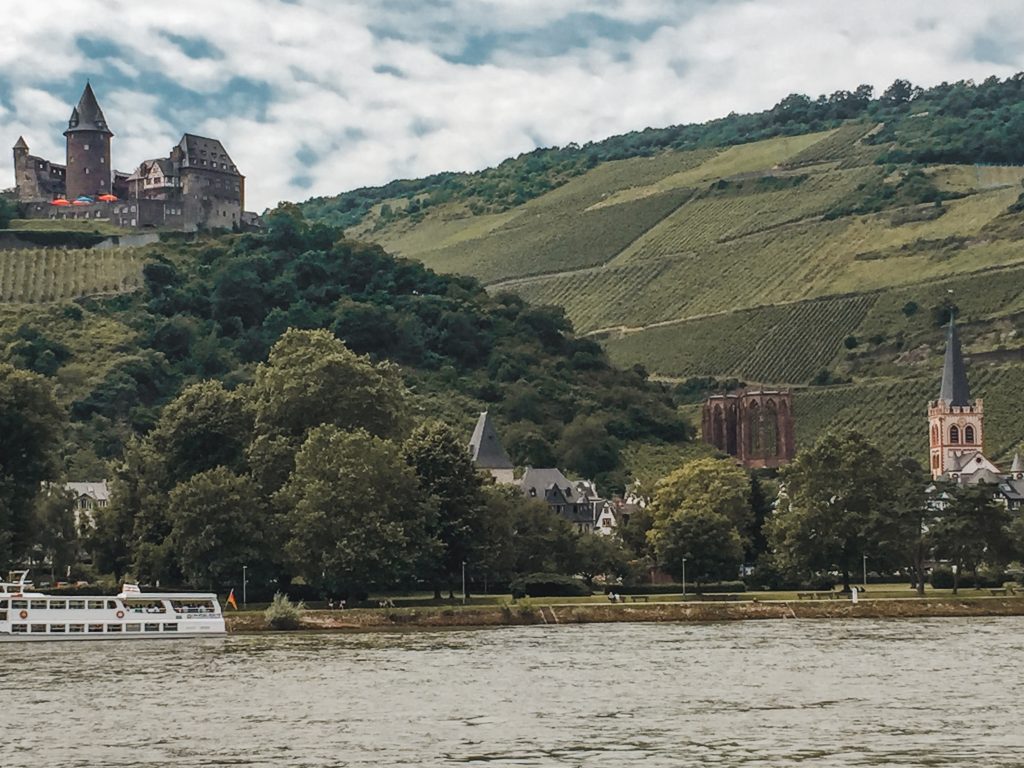
Stahleck
Stahleck Castle was built in the 10th century by the Archbishop of Cologne and features a rare characteristic of German castles, a moat. In the 11th century, Goswin von Falkenburg inherited the castle through his marriage to Luitgard von Hengebach, a widow of a Holy Roman Empire King. Their son married a woman who was brothers with King Conrad III of Germany. In 1140, that son exchanged Stahleck to King Conrad. This in turn made him one of the greatest Lords of the Holy Roman Empire because he already owned two other castles along the Rhine River. Since Stahleck was between the two, he made Bacharach into a trading town for the wine they grew on the vineyards. After many deaths, inheritances and exchanges of hands, Stahleck was conquered and destroyed multiple times during the Thirty Years’ War. Spaniards and French continued to capture the castle but it ultimately was blown up by the French in 1689. The castle ruins continued to be traded to different hands but in 1909, it was passed over to a restoration organization by the Prussians.
In 1925, the castle was turned over to the Rhineland-Palatinate Youth Hostel Association. It still operates as a hostel today with 168 beds.

Burg Gutenfels
Burg Gutenfels was built in 1220 and was used as a toll castle per the Holy Roman Empire. Pfalzgrafenstein is the small white castle on its own island in the middle of the Rhine River. Built to guard customs posts and for long-distance trade routes, it served as a sort of border crossing. Back in its prime, walls connected the two castles, leading directly down from Gutenfels and across the water to Pfalzgrafenstein. Prussia purchased the castle in 1866, ending the tolls a year later.
Today, the castle is a UNESCO World Heritage Sight and was once used as a hotel but transferred to a private residence in 2006.
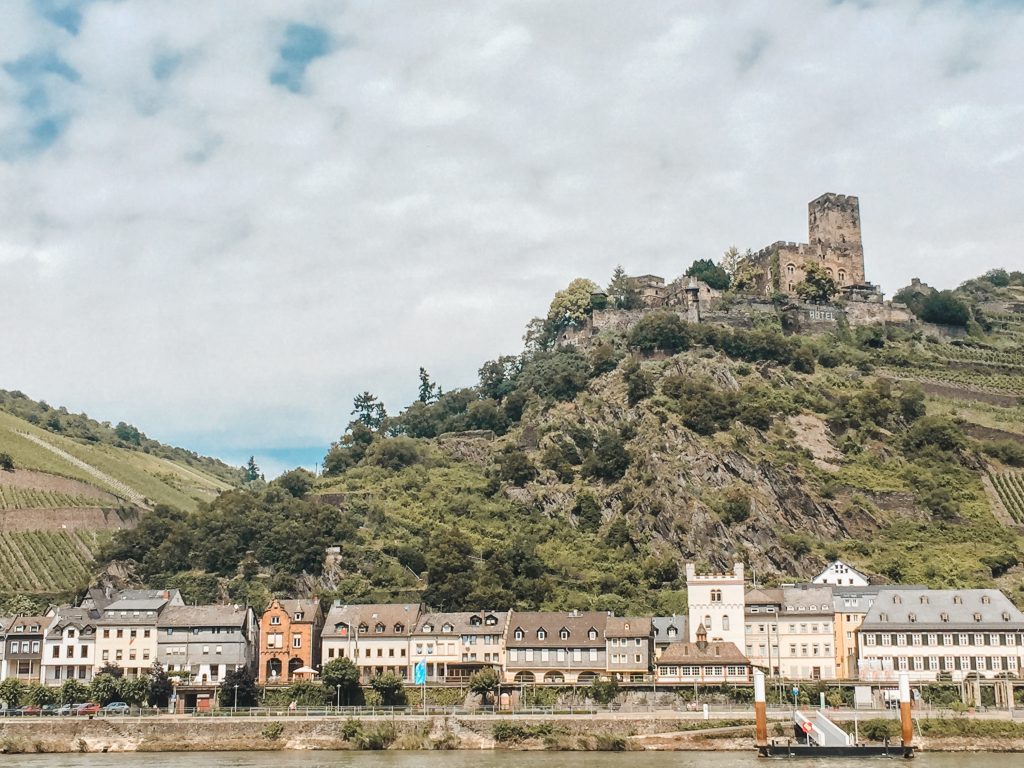
Schönburg
Schönburg Castle was first mentioned in the early 900s, with the Duke of Schönburg imposing tolls and taxes for passing by. The bloodline of all heirs eventually died out in the 1600s. It was then burnt down by French troops during the Palatinate Wars. The ruins of the castle were left for two centuries until it was restored.
Today it’s leased to a family who operates a restaurant and hotel there.
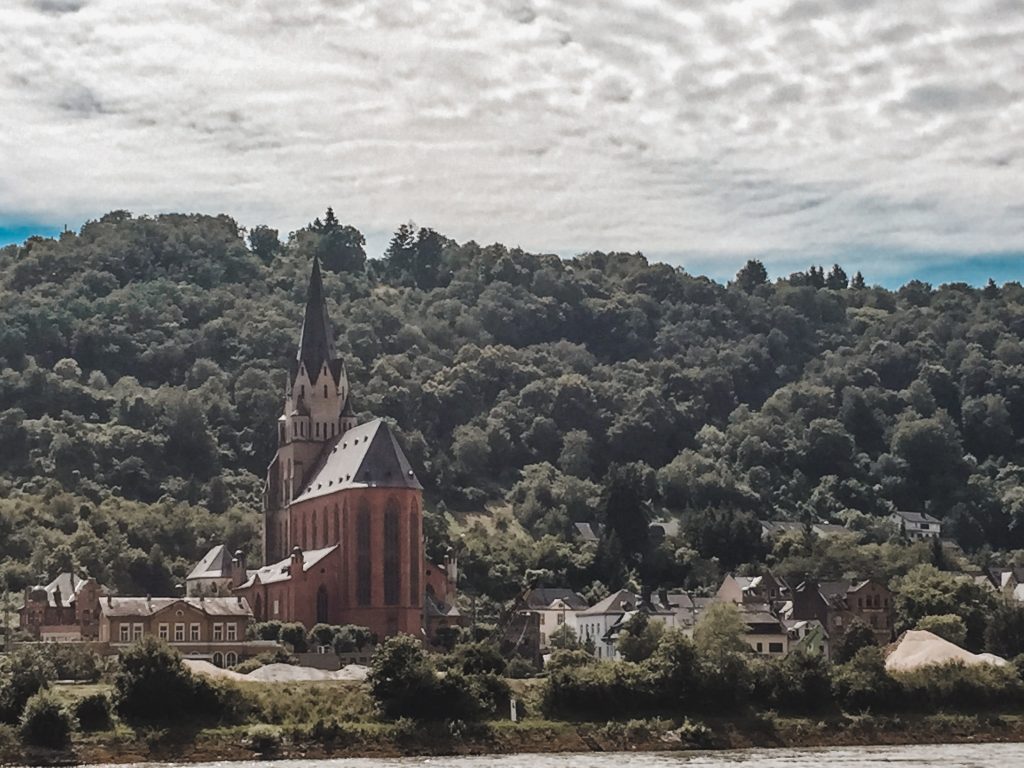
Loreley
Loreley is the name for the large cliff that juts out into the Rhine River. Synonymous with many myths and legends, the name comes from German and Celtic terms meaning ‘murmuring rock.’ Legend says that a mermaid, scorned by her lover, would sit on the edge of this rock brushing her golden hair and singing sweet tunes. Apparently this caused the captains of the ships below to wreck into the rock. Loreley has been the focus of many German poems and songs, allowing the folklore legend to live on.
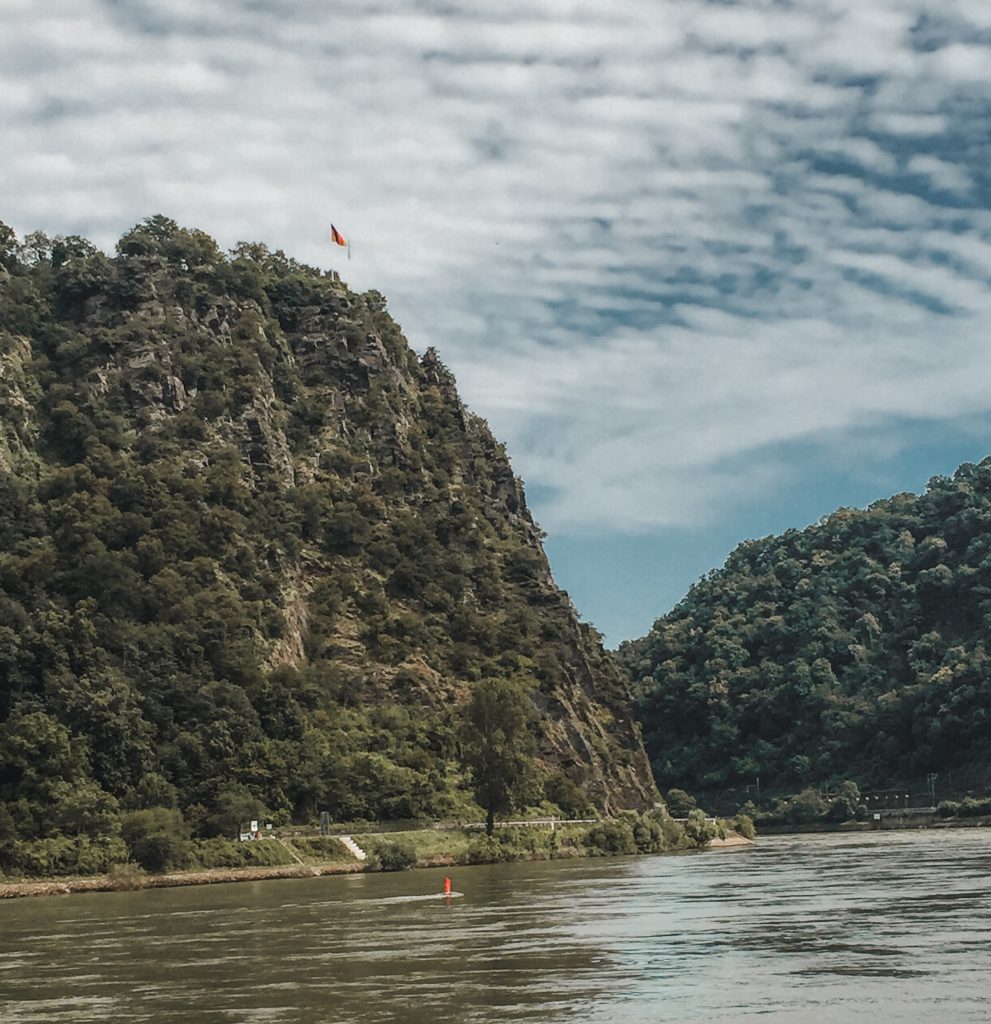
Burg Kats
Located around the bend of Loreley, Burg Katz was constructed in 1371 by Count William II of Katzenelnbogen. In 1435, the Count was the first to plant a Riesling vineyard here which still exists today. Burg Katz was seized and destroyed by Napolean in 1806.
The castle was restored in 1896 and is now privately owned.
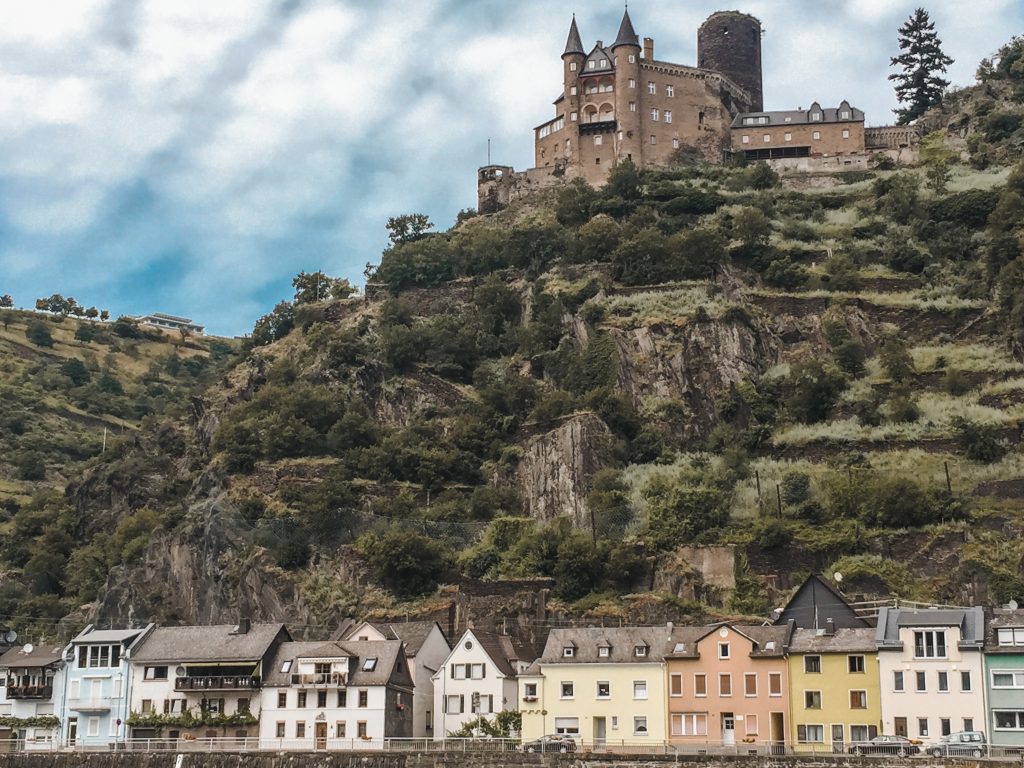
Rheinfels
Constructed by Count Diether V of Katzenelnbogen in 1245, Rheinfels is the largest fortress in the Middle Rhein Valley. It’s also the largest castle on the Rhine River. Rheinfels features the largest butter-churn tower in Germany and the largest self-supporting vaulted cellar in Europe. The cellar can fit up to 400 people and is used today as a meeting place for concerts and other events.
In 1797, the French Revolutionary Army destroyed the castle completely.
While much of the castle remains as ruins today, the fortress is so massive that it supports a luxury hotel, a restaurant, wellness center and a museum.
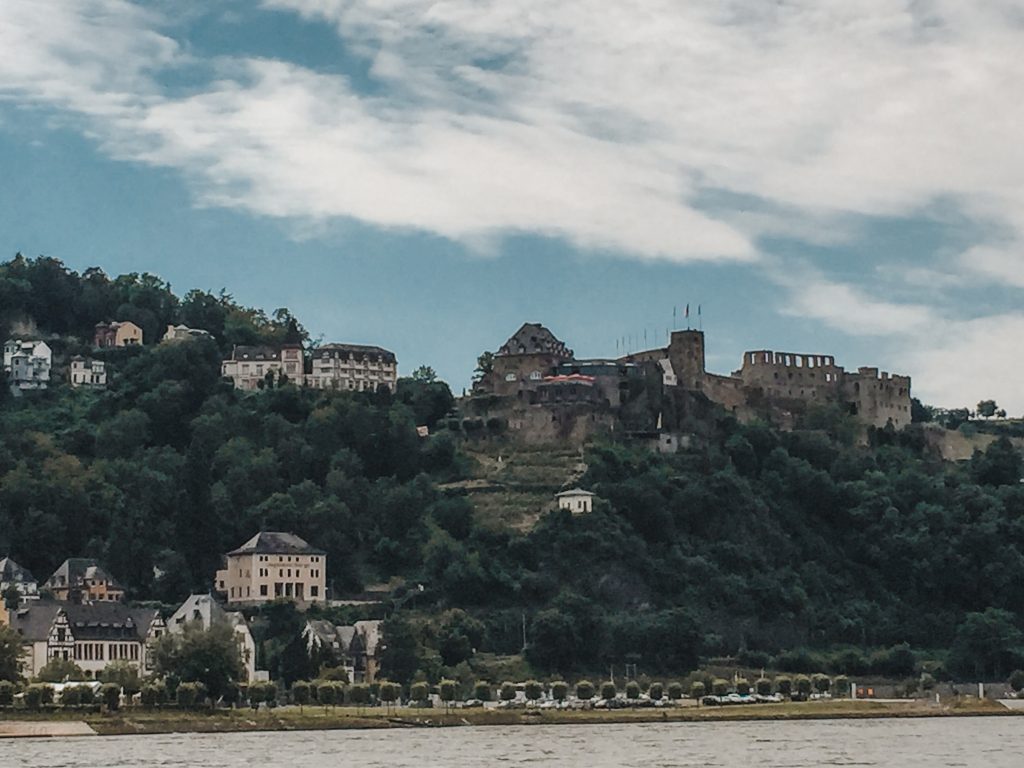
Like This Post? Pin It!
| This post contains affiliate links which means that, at no extra cost to you, if you purchase one of these products I may receive a small commission. This helps me maintain my blog as a free space to you. Check out my Disclaimer for more info.
